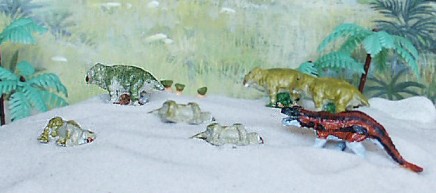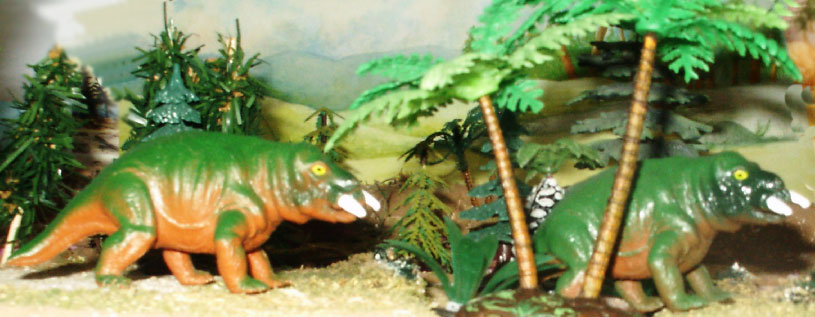LATE TRIASSIC NORIAN AGE
Western United States. Updated 091612
The Placerias Quarry of northeastern Arizona is one of the most diverse Triassic vertebrate fossil localities in the world. Fossils of forty Placerias were found near St. Johns, southeast of the Petrified Forest in Arizona. This a medium sized herbivore. This is the last of dicynodonts they are no longer common in the Norian perhaps because they required a wetter habitat.
Placerias the last of the dicynodonts plays the tragic role in Walking witg Dinosaurs. These animals are not dinosaurs but related to mammals. The dicynodonts dominated the last of the Permian and the first half of the Triassic. Walking with Dinosaurs portrays these animals as doomed relics poorly adapted to the hot dry climates of the Late Triassic. Although their ancestors were the most successful survivors of the Late Permian extinction when the climate was probably even more extreme. The change in vegetation may have been a more critical factor, or just bad luck, in their extinction. There is a bias in popular thinking that says survivors must have some natural evolutionary advantage over a species that dies out. So we construct these scenarios finding reasons why dinosaurs out competed their contemporaries. The same thing happens at the end of the Cretaceous when dinosaurs are snuffed out and there are all the theories developed proving mammals were superior. There were a series of extinctions in the Late Triassic that seemed to clear the stage for the dinosaurs to fill up the world. Which they did very spectacularly.

One of the last stands of Placerias is the American southwest. Over 40 fossils of this 1 ton animal have been found in the Petrified Forest of Arizona.

Current thought is Pangaea was a environment that alternated between super monsoons and extreme aridity. Periodically the monsoons fail as the the movement of the plates disrupts the weather patterns and the flora and fauna is decimated. After each drought Placerias is slow to recover and eventually dies out. Postosuchus is adapted to preying on Placerias so as Placerias goes so does Postosuchus.
